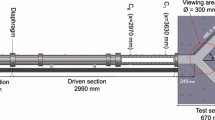Abstract
To determine the extent and magnitude of reflected-shock bifurcation in shock-tube chemistry studies at elevated pressures, experiments were performed using a simple laser schlieren technique and a fast- response pressure transducer. The laser schlieren diagnostic provided a quantitative measurement of the normal-shock passage, an event normally obscured in pressure signals by the bifurcated region. A range of gas mixtures covering molecular weights from 14.7 to 44.0 and specific heat ratios from 1.29 to 1.51 was explored. The results were combined with a standard gas dynamic model to determine the time of arrival of the normal shock wave, the size and strength of the bifurcated region, and the characteristic passage times of dominant features. All results could be expressed in empirical correlations as functions of the gas properties and shock speed. The measured size of the bifurcation zone increased with increasing shock velocity and decreasing specific heat ratio, but displayed no pressure dependence for the conditions of this study (P 5 = 11 − 265 atm., T 5 = 780 − 1740 K).
Similar content being viewed by others
References
Mark H. The interaction of a reflected shock wave with the boundary layer in a shock tube. NACA TM 1418 (1958)
Strehlow R., Cohen A.(1959) Limitations of the reflected shock technique for studying fast chemical reactions and its application to the observation of relaxation in nitrogen and oxygen. J. Chem. Phys. 30: 257–265
Center R. (1963) Reflected shock interaction with shock tube boundary layers. Phys. Fluids 6: 307–308
Dyner H. (1966) Density variation due to reflected shock-boundary-layer interaction. Phys. Fluids 9: 879–892
Honda M., Takayama K., Onodera O., Kohama Y. (1975) Motion of reflected shock waves in shock tube. In: Kamimoto G. (ed) Modern Developments in Shock Tube Research Proceedings of the 10th International Shock Tube Symposium. Shock Tube Research Society, Japan, pp. 320–327
Fokeev V., Gvozdeva L. (1990) Study of bifurcation of reflected shock waves in channels of various cross-sections. In: Kim Y. (ed) Current Topics in Shock Waves Proceedings of the 17th International Symposium on Shock Waves and Shock Tubes. AIP, New York, pp. 862–866
Bull D., Edwards D. (1968) An investigation of the reflected shock interaction process in a shock tube. AIAA J. 6: 1549–1555
Davies L., Wilson J. (1969) Influence of reflected shock and boundary-layer interaction on shock-tube flows. Phys. Fluids Suppl. I: I37–I43
Dumitrescu L., Popescu C., Brun R.(1970) Experimental studies of the shock reflection and interaction in a shock tube. In: Glass I. (ed) Shock Tubes Proceedings of the 7th International Shock Tube Symposium. University of Toronto Press, Toronto, pp. 751–770
Kleine H., Lyakhov V., Gvozdeva L., Grönig H.(1991) Bifurcation of a reflected shock wave in a shock tube. In: Takayama K. (ed) Shock Waves Proceedings of the 18th International Symposium on Shock Waves. Springer, Berlin, Heidelberg, New York, pp. 261–266
Wilson G., Sharma S., Gillespie W. Time-dependent simulation of reflected-shock/boundary layer interaction in shock tubes. In: Brun R., Dumitrescu L. (eds.) Shock Waves @ Marseille I. Proceedings of the 19th International Symposium on Shock Waves, pp. 439–444. Springer, Berlin, Heidelberg, New York (1995)
Nishida M., Lee M. (1996)Reflected shock/side boundary layer interaction in a shock tube. In: Sturtevant B., Shepherd J., Hornung H. (eds) Proceedings of the 20th International Symposium on Shock Waves. World Scientific, Singapore, pp. 705–710
Daru V., Fernandez G., Tenaud C. On CFD to investigate bifurcated shock wave pattern. In: Houwing F. (ed.) Proceedings of the 21st International Symposium on Shock Waves, Paper 1950 (1997)
Takano Y. (1987) Simulations for effects of side-wall boundary-layer on reflected-shock flowfields in shock tubes. In: Grönig H. (ed) Shock Tubes and Waves. Proceedings of the 16th International Symposium on Shock Tubes and Waves. VCH, New York, pp. 645–651
Petersen E., Davidson D., Hanson R. (1999) Ignition delay times of ram accelerator CH4/O2/diluent mixtures. J. Prop. Power 15: 82–91
Petersen E. A shock tube and diagnostics for chemistry measurements at elevated pressures with application to methane ignition. PhD thesis, Stanford University (1998)
Petersen E., Hanson R. (2003) Improved turbulent boundary-layer model for shock tubes. AIAA J. 41: 1314–1322
Byron S., Rott N (1958) On the interaction of the reflected shock wave with the laminar boundary layer on the shock tube walls. In: Binder R., Epstein M., Mannes R., Yang H. (eds) Proceedings of the Heat Transfer and Fluid Mechanics Institute. Stanford University Press, Stanford, pp. 38–54
Sanderson R. (1969) Interpretation of pressure measurements behind the reflected shock in a rectangular shock tube. AIAA J. 7: 1370–1372
Brun R., Auberger P., Van Que N. (1978) Shock tube study of boundary layer instability. Acta Astro. 5: 1145–1152
Author information
Authors and Affiliations
Corresponding author
Additional information
Communicated by F. Lu
Rights and permissions
About this article
Cite this article
Petersen, E.L., Hanson, R.K. Measurement of Reflected-shock Bifurcation Over a Wide Range of Gas Composition and Pressure. Shock Waves 15, 333–340 (2006). https://doi.org/10.1007/s00193-006-0032-3
Received:
Revised:
Accepted:
Published:
Issue Date:
DOI: https://doi.org/10.1007/s00193-006-0032-3




